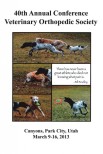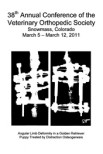Objective: To determine if intra-articular implant penetration (IAIP) could be detected with radiography when implants were placed at predetermined positions within the canine stifle.
Study design: Experimental cadaveric study.
Sample population: Five skeletally mature canine cadavers.
Methods: Periarticular implants (3.5 mm stainless steel cortical screws) were placed in the proximomedial tibia and directed toward either the medial or lateral tibial condyle to a predetermined distance from the joint surface: -2 mm (below the joint surface), 0 mm (at the level of the subchondral bone), and 2 mm (above the joint surface). Joint examination was performed to confirm IAIP. Standard orthogonal radiographic views of the stifle were obtained. Radiographs were reviewed by registered small animal surgery and radiology specialists, residents, and board-eligible residents via an online survey.
Results: Overall, 32.4% of radiographs were incorrectly classified as penetrating the joint surface. Implants directed toward the lateral tibial condyle were misclassified more frequently than those directed toward the medial tibial condyle (23.8% vs. 8.3%, respectively). The overall accuracy of detecting IAIP of the stifle with radiography was 77.9% with a sensitivity and specificity of 97.2% and 67.6%, respectively.
Conclusion: Approximately 32% of non-penetrating implants were incorrectly identified as penetrating the joint, particularly those directed laterally. The overall accuracy of radiography for the detection of IAIP of the stifle was 78%.
Clinical significance: While radiography can be effective in detecting IAIP, there is a significant rate of misclassification, especially for non-penetrating implants, which may lead to unnecessary interventions.









